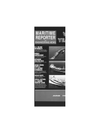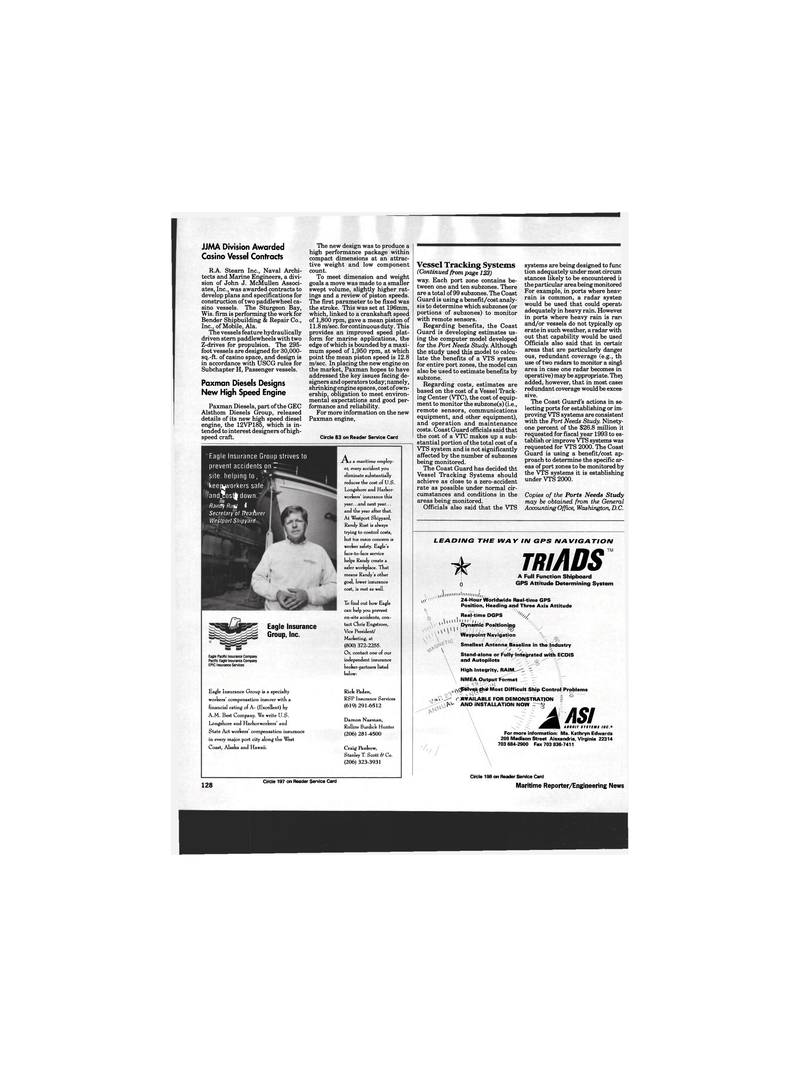
Page 127: of Maritime Reporter Magazine (June 1993)
Read this page in Pdf, Flash or Html5 edition of June 1993 Maritime Reporter Magazine
JJMA Division Awarded
Casino Vessel Contracts
R.A. Stearn Inc., Naval Archi- tects and Marine Engineers, a divi- sion of John J. McMullen Associ- ates, Inc., was awarded contracts to develop plans and specifications for construction of two paddlewheel ca- sino vessels. The Sturgeon Bay,
Wis. firm is performing the work for
Bender Shipbuilding & Repair Co.,
Inc., of Mobile, Ala.
The vessels feature hydraulically driven stern paddlewheels with two
Z-drives for propulsion. The 295- foot vessels are designed for 30,000- sq.-ft. of casino space, and design is in accordance with USCG rules for
Subchapter H, Passenger vessels.
Paxman Diesels Designs
New High Speed Engine
Paxman Diesels, part of the GEC
Alsthom Diesels Group, released details of its new high speed diesel engine, the 12VP185, which is in- tended to interest designers of high- speed craft.
The new design was to produce a high performance package within compact dimensions at an attrac- tive weight and low component count.
To meet dimension and weight goals a move was made to a smaller swept volume, slightly higher rat- ings and a review of piston speeds.
The first parameter to be fixed was the stroke. This was set at 196mm, which, linked to a crankshaft speed of 1,800 rpm, gave a mean piston of 11.8m/sec.forcontinuousduty. This provides an improved speed plat- form for marine applications, the edge of which is bounded by a maxi- mum speed of 1,950 rpm, at which point the mean piston speed is 12.8 m/sec. In placing the new engine on the market, Paxman hopes to have addressed the key issues facing de- signers and operators today; namely, shrinking engine spaces, cost of own- ership, obligation to meet environ- mental expectations and good per- formance and reliability.
For more information on the new
Paxman engine,
Circle 83 on Reader Service Card
Vessel Tracking Systems (Continued from page 123) way. Each port zone contains be- tween one and ten subzones. There are a total of 99 subzones. The Coast
Guard is using a benefit/cost analy- sis to determine which subzones (or portions of subzones) to monitor with remote sensors.
Regarding benefits, the Coast
Guard is developing estimates us- ing the computer model developed for the Port Needs Study. Although the study used this model to calcu- late the benefits of a VTS system for entire port zones, the model can also be used to estimate benefits by subzone.
Regarding costs, estimates are based on the cost of a Vessel Track- ing Center (VTC), the cost of equip- ment to monitor the subzone(s) (i.e., remote sensors, communications equipment, and other equipment), and operation and maintenance costs. Coast Guard officials said that the cost of a VTC makes up a sub- stantial portion of the total cost of a
VTS system and is not significantly affected by the number of subzones being monitored.
The Coast Guard has decided tht
Vessel Tracking Systems should achieve as close to a zero-accident rate as possible under normal cir- cumstances and conditions in the areas being monitored.
Officials also said that the VTS systems are being designed to func tion adequately under most circum stances likely to be encountered i) the particular area being monitored
For example, in ports where heav rain is common, a radar systen would be used that could operatt adequately in heavy rain. However in ports where heavy rain is rart and/or vessels do not typically op erate in such weather, a radar with out that capability would be used
Officials also said that in certair areas that are particularly danger ous, redundant coverage (e.g., th use of two radars to monitor a singl area in case one radar becomes in operative) may be appropriate. Thej added, however, that in most cases redundant coverage would be exces- sive.
The Coast Guard's actions in se- lecting ports for establishing or im- proving VTS systems are consistent with the Port Needs Study. Ninety- one percent of the $26.8 million it requested for fiscal year 1993 to es- tablish or improve VTS systems was requested for VTS 2000. The Coast
Guard is using a benefit/cost ap- proach to determine the specific ar- eas of port zones to be monitored by the VTS systems it is establishing under VTS 2000.
Copies of the Ports Needs Study may be obtained from the General
Accounting Office, Washington, D.C.
LEADING THE WA Y IN GPS NAVIGATION -k TRIADS A Full Function Shipboard
GPS Attitude Determining System wv ut\m 0 I minium iinlu , 24-Hour Worldwide Real-time GPS
Position, Heading and Three Axis Attitude
Real-time DGPS i! 11 a 111, \ \ i * ^ Dynamic Positioning
V \
Waypoint Navigation %
Smallest Antenna Baseline in the Industry /' 's \
Stand-alone or Fully-Integrated with ECDIS and Autopilots
High Integrity, RAIM-—C C
NMEA Output Format o Most Difficult Ship Control Problems • - AVAILABLE FOR DEMONSTRATION § ° ^ AND installation now r-fy AASI ^^^^^ ADROIT SYSTEM. 128 Circle 197 on Reader Service Card
SYSTEMS IMC."
For more information: Ms. Kathryn Edwards 209 Madison Street Alexandria, Virginia 22314 703 684-2900 Fax 703 836-7411
Circle 198 on Reader Service Card
Maritime Reporter/Engineering News
Eagle Insurance Group strives to prevent accidents on H site, helping to . keep^workers safe and$os1| down
Ranty Rusf i
Secretary of Tteahrer
Westport Shipyard
Eagle Insurance
Group, Inc.
Eagle Pacific Insurance Company
Pacific Eagle Insurance Company
EPIC Insurance Services
As a maritime employ- er, every accident you eliminate substantially reduces the cost of U.S.
Longshore and Harhor- workers' insurance this year...and next year... and the year alter that.
At Westport Shipyard,
Randy Rust is always trying to control costs, hut his main concern is worker safety. Eagle's face-to-face service helps Randy create a safer workplace. That means Randy's other goal, lower insurance cost, is met as well.
To find out how Eagle can help you prevent on-site accidents, con- tact Chris Engstrom,
Vice President/
Marketing, at (800) 372-2255.
Or, contact one of our independent insurance hroker-partners listed helow:
Eagle Insurance Group is a specialty workers' compensation insurer with a financial rating of A- (Excellent) hy
A.M. Best Company. We write U.S.
Longshore and Harhorworkers' and
State Act workers' compensation insurance in every major port city along the West
Coast, Alaska and Hawaii.
Rick Paden,
RSP Insurance Services (619) 291-6512
Damon Nasman,
Rollins Burdick Hunter (206) 281-4500
Craig Pankow,
Stanley T. Scott & Co. (206) 323-3931

 126
126

 128
128
